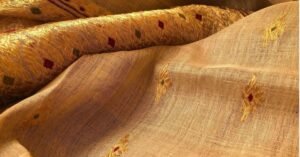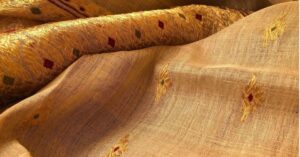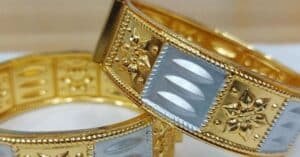Pure Muga Silk from Assam is a precious rarity. Due to its scarcity and soaring demand, the market is flooded with inferior grades of Muga silk. To distinguish the genuine from the counterfeit, and the finest from the second-rate, a fundamental grasp of Muga silk’s origins, production methods, and distinguishing features is essential. This blog aims to provide a solution to the query “How To Identify Muga Silk”.
Muga Silk Facts
Muga Silk is made out of Muga silkworm (Antheraea Assamensis) which is endemic to Assam. It is the second most expensive silk in the world after Pashmina. To produce 500 grams of raw muga silk around 2500 silkworms are needed. On average, a saree (6-8 square metres) needs 1000 cocoons of muga silkworms. Now imagine, making silk out of 1000 silkworms just to make one saree.Huge amount of manual labour is needed to produce just one saree of any piece of cloth made of Muga silk. That is why it is so expensive.
How To Identify Muga Silk?
There are various methods to identify Muga Silk of Assam. Initially, observation and familiarity play crucial roles. If you already own a muga silk of finest quality, just by touching the cloth you would feel the difference, because no other fabric is as close as muga silk in terms of quality.
However, if you are a first time buyer, you may have to rely on lab certification and GI tag to identify muga silk. we will explain the both process here in this blog.
Identification of Muga Silk by Observation
Identifying pure Muga silk can be as straightforward as recognizing its distinct characteristics, appearance, and texture. Here are key indicators to keep in mind:
Golden color: Muga silk’s most defining trait is its inherent golden hue, a feature unparalleled by other silk varieties. Often hailed as ‘nature’s gold’, this unique coloration is a hallmark of Muga silk.
Luxurious sheen: With its opulent sheen, Muga silk boasts a lavish and glossy surface. This luminous quality is remarkably striking, imparting an air of elegance and sophistication to the fabric.
Identification of Muga Silk by its Certification
Silk Mark Tag: Look for the Silk Mark tag issued by the Silk Mark Organisation of India. This tag is often attached to genuine silk products and indicates that the silk has been tested and certified. However, be cautious as counterfeiters may also attempt to replicate this tag. You can verify the authenticity of the Silk Mark tag by scanning the QR code on the tag and verifying it with on the Silk Mark website.
GI Tag for Muga Silk: If you are purchasing Muga silk, which is a special type of silk produced in Assam, ensure that the product has a Geographical Indication (GI) tag. Muga silk from Assam was granted GI status in 2007. The GI tag certifies that the product has specific characteristics and qualities attributable to its geographical origin, in this case, Assam. The presence of the GI tag adds credibility to the authenticity of the Muga silk product.
Additionally, consider the reputation and credibility of the seller before making a purchase.
Let’s understand with an example:
The image above showcases a Muga Silk Saree accompanied by certification and a GI tag. Notably, the certificate is issued by the Sualkuchi Silk Testing Laboratory. It’s worth mentioning that Sualkuchi serves as the primary hub for the silk handloom and textile industry in Assam. The Sualkuchi Silk Testing Laboratory holds government certification and conducts tests on various types of silk. In the test results, the presence of Muga silk is indicated by a tick. If the saree contains a blend of Muga and Mulberry silk, both Muga and Mulberry boxes will be marked.
Muga Silk is often combined with Oak-Tasar, Mulberry (Pat), Eri, Endi, and other non-Mulberry fibers. Every saree produced in Sualkuchi must undergo mandatory testing, with specific boxes checked accordingly. Following testing, the saree is certified as pure Muga, denoted by the tick solely in the Muga box.
GI Tag Validation To Identify Muga Silk
Geographical Indication (GI) is a system that identifies goods with special qualities or characteristics linked to specific geographic conditions. Muga silk attained GI recognition in 2007 and received a trademarked logo in 2014. This logo, registered with a patent, ensures product authenticity and protection. The attached GI logo in the image can be scanned via QR code to verify both the seller’s authenticity and the product’s origin as genuine Muga silk.
The Best Quality Muga Silk from Assam
Muga Silk exhibits variability in quality due to its natural harvesting process and minimal chemical intervention, making it a 100% natural fiber without added chemicals or synthetic elements. However, consistency in quality is not guaranteed.
Numerous factors impact the characteristics and quality of Muga silk sarees, including the season of silkworm rearing, weather conditions, geographical location, hygiene of the silkworm rearing facility, and notably, the quality of the leaves (from Som and Soalu trees) consumed by Muga silkworms. Crops harvested during the Kati (Oct-Nov) and Jeth (Apr-May) month of Assamese Calender are esteemed for their superior reel-ability (resistance to breakage) and longer single filament length.
Reports of Fake Muga Silk
The prevalence of cheaper imitation materials flooding the market, particularly from trading hubs like Varanasi and Surat, raises concerns about the authenticity of Muga Silk Fabric. Despite the wholesale price of pure Muga Silk reaching 15000 INR per meter in Sualkuchi, the primary production center, traders are selling it for as low as 9000 INR per meter. This significant price difference stems from the influx of inferior varieties flooding the market, often blended with cotton, mulberry silk, tasar silk, and other fabrics to reduce costs.
While these tactics may seem harmless, it’s essential to recognize that pure Muga is akin to gold, unmatched in its quality and feel. Although blends may offer a cheaper alternative and appear visually appealing, they fail to replicate the original’s quality and texture. Therefore, consumers should remain vigilant and prioritize authentic Muga Silk to ensure they experience its true essence and value.





